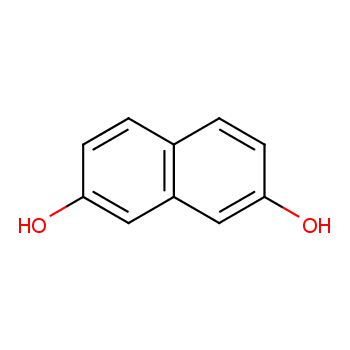2,7-Dihydroxynaphthalene, also known as 2,7-naphthalenediol, is an organic compound with a molecular formula of C??H?O? and a molecular weight of 160.17. This compound is a solid powder at room temperature, with a melting point typically between 184°C and 189°C, and a density of about 1.33. 2,7-Dihydroxynaphthalene is soluble in ethanol, diethyl ether, and hot water, slightly soluble in benzene and chloroform, and almost insoluble in petroleum ether. It is important to note that this compound is prone to oxidation in air, causing the solution color to darken rapidly. Additionally, 2,7-Dihydroxynaphthalene is classified as an irritant, causing irritation to the eyes, respiratory system, and skin, so caution is advised when handling it [1-2].

2,7-Dihydroxynaphthalene characteristics
Synthesis Method
To synthesize 2,7-Dihydroxynaphthalene, a certain amount of 2,7-naphthalenedisulfonic acid sodium salt, sodium hydroxide (and possibly other additives such as sodium oxide), and a solvent (such as dodecane) are added to a high-pressure reactor. The mixture is heated to a high temperature (e.g. 290°C) with stirring, and maintained at this temperature for a certain period (e.g. 8 hours) to allow for complete reaction of the raw materials. The resulting mixture is then cooled to room temperature, filtered to remove solid impurities. Subsequently, the filtrate is neutralized with concentrated sulfuric acid to a certain pH value (e.g. pH=1), forming a suspension. The suspension is filtered, and the filter cake is dried to obtain the 2,7-Dihydroxynaphthalene product. Although this method is widely used in industrial production, it has some drawbacks such as the consumption of large amounts of sodium hydroxide, the formation of by-product 1-hydroxynaphthalene, and low yield. Therefore, researchers are continuously exploring more efficient and environmentally friendly synthesis methods [2-3].
Applications
In the pharmaceutical field, 2,7-Dihydroxynaphthalene can serve as a key intermediate for synthesizing various drugs. Through further chemical reactions, specific pharmacologically active compounds can be prepared for the treatment of various diseases. These compounds may exhibit antibacterial, anti-inflammatory, anti-tumor, and other biological activities.
In the dye industry, 2,7-Dihydroxynaphthalene also plays an important role in dye synthesis. It can be used as a raw material for synthesizing various dyes, providing a wide range of colorful dye products for the textile, leather, and other industries. These dyes not only have good dyeing properties but also exhibit high wash and lightfastness [1-3].
References
[1] Yu R.Q., Zhang Z.Q., Zeng G.M., et al. Azo derivatives of 2,7-Dihydroxynaphthalene as analytical reagents[J]. Chemical Reagents, 1983(04):24-30.
[2] Hu X.B., Yuan Z.F., Huang C.H. A method for synthesizing 2,7-Dihydroxynaphthalene. CN201810338328.2[2024-07-22].
[3] Zong Q.S., Miao C.P., Wu J.Y., et al. Synthesis of naphthalene-benzene bis-crown ethers based on 2,7-Dihydroxynaphthalene[C]//Organic Chemistry Academic Conference of the Chinese Chemical Society. 2009.




